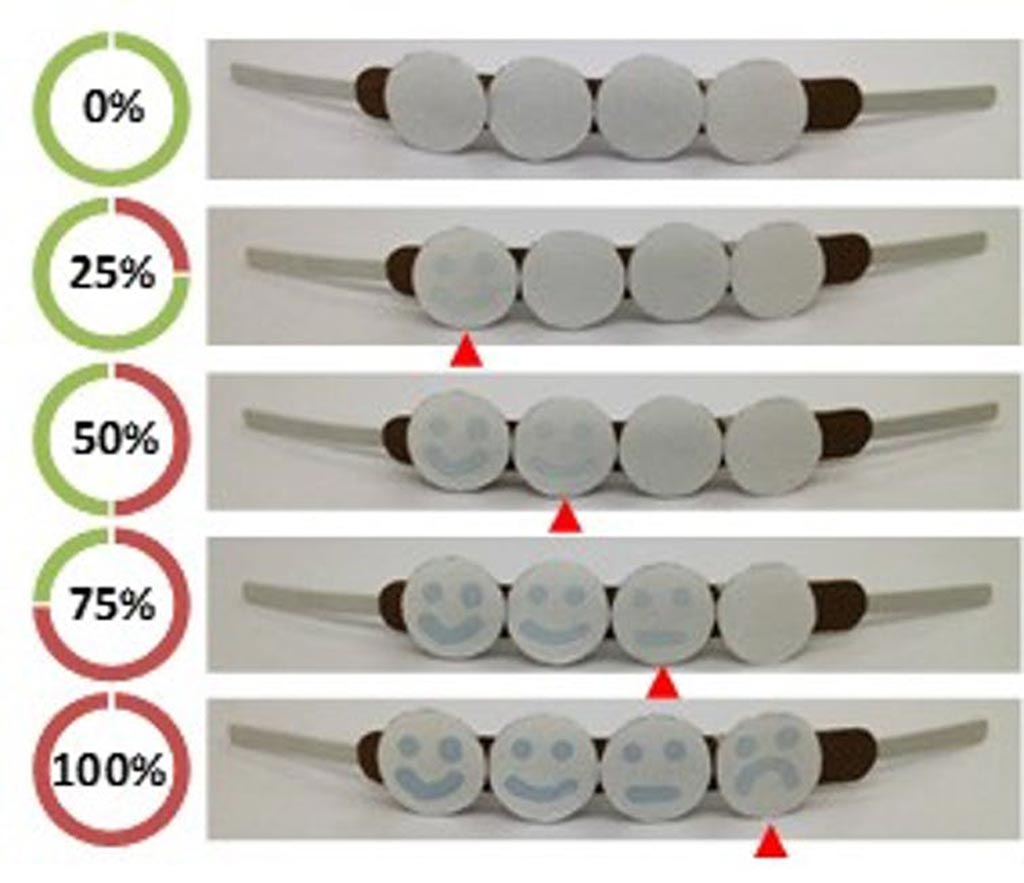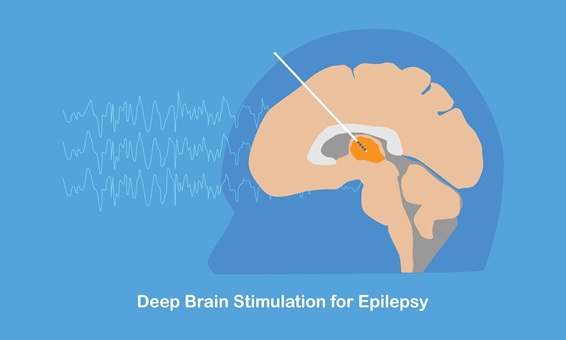Wristband Device Tracks UV Exposure
|
By HospiMedica International staff writers Posted on 17 Oct 2018 |

Image: Emoticon faces on the wristband successively light up as exposure to UV radiation increases (Photo courtesy of RMIT).
A new study describes how a low-cost ultraviolet (UV) dosimetry wristband can warn users when their exposure to the sun has become dangerous.
Developed by researchers at the University of Granada (UGR; Spain), and RMIT University (Melbourne, Australia), the paper-based wristband can provide spectrally selective colorimetric monitoring of ultraviolet radiations (UVR) with the aid of a photo-electrochromic ink that consists of a multi-redox polyoxometalate, an e− donor, and transparency sheets. Importantly, the real-time solar dosimeters also meet the specific need of different skin colors, which demands personalized sensors.
The researchers have created six versions of the color-changing wristbands, each personalized for a specific skin tone, as darker people need more sun exposure to produce vitamin D, essential for healthy bones, teeth, and muscles. The paper-based sensor features happy and sad emoticon faces, drawn in an invisible UV-sensitive ink that successively lights up at 25%, 50%, 75%, and 100% of daily recommended UV exposure. The study was published on September 25, 2018, in Nature Communications.
“While humans do need some sun exposure to maintain healthy levels of Vitamin D, excessive exposure can cause sunburn, skin cancer, blindness, skin wrinkling, and premature signs of aging. Knowing what a healthy amount is for you depends on understanding your personal classification, from Type I to VI, as each has very different solar exposure needs,” said senior author Professor Vipul Bansal, PhD, or RMIT. “We are excited that our UV sensor technology allows the production of personalized sensors that can be matched to the specific needs of a particular individual. The low cost and child-friendly design of these UV sensors will facilitate their use as educational materials to increase awareness around sun safety.”
Currently, the only guide for managing sun exposure is UV index, which only indicates the intensity of UV rays, and cannot monitor individual phototypes daily exposure. For example, fair skin (Type I) can only tolerate only one fifth of the UV exposure that dark skin (Type VI) can before damage occurs, while darker types require longer in the sun to absorb healthy amounts of Vitamin D. The discovery also has application beyond the health sector, as over time UV rays can have damaging effects on the lifetime of many industrial and consumer products.
Related Links:
University of Granada
RMIT University
Developed by researchers at the University of Granada (UGR; Spain), and RMIT University (Melbourne, Australia), the paper-based wristband can provide spectrally selective colorimetric monitoring of ultraviolet radiations (UVR) with the aid of a photo-electrochromic ink that consists of a multi-redox polyoxometalate, an e− donor, and transparency sheets. Importantly, the real-time solar dosimeters also meet the specific need of different skin colors, which demands personalized sensors.
The researchers have created six versions of the color-changing wristbands, each personalized for a specific skin tone, as darker people need more sun exposure to produce vitamin D, essential for healthy bones, teeth, and muscles. The paper-based sensor features happy and sad emoticon faces, drawn in an invisible UV-sensitive ink that successively lights up at 25%, 50%, 75%, and 100% of daily recommended UV exposure. The study was published on September 25, 2018, in Nature Communications.
“While humans do need some sun exposure to maintain healthy levels of Vitamin D, excessive exposure can cause sunburn, skin cancer, blindness, skin wrinkling, and premature signs of aging. Knowing what a healthy amount is for you depends on understanding your personal classification, from Type I to VI, as each has very different solar exposure needs,” said senior author Professor Vipul Bansal, PhD, or RMIT. “We are excited that our UV sensor technology allows the production of personalized sensors that can be matched to the specific needs of a particular individual. The low cost and child-friendly design of these UV sensors will facilitate their use as educational materials to increase awareness around sun safety.”
Currently, the only guide for managing sun exposure is UV index, which only indicates the intensity of UV rays, and cannot monitor individual phototypes daily exposure. For example, fair skin (Type I) can only tolerate only one fifth of the UV exposure that dark skin (Type VI) can before damage occurs, while darker types require longer in the sun to absorb healthy amounts of Vitamin D. The discovery also has application beyond the health sector, as over time UV rays can have damaging effects on the lifetime of many industrial and consumer products.
Related Links:
University of Granada
RMIT University
Latest Patient Care News
- Revolutionary Automatic IV-Line Flushing Device to Enhance Infusion Care
- VR Training Tool Combats Contamination of Portable Medical Equipment
- Portable Biosensor Platform to Reduce Hospital-Acquired Infections
- First-Of-Its-Kind Portable Germicidal Light Technology Disinfects High-Touch Clinical Surfaces in Seconds
- Surgical Capacity Optimization Solution Helps Hospitals Boost OR Utilization

- Game-Changing Innovation in Surgical Instrument Sterilization Significantly Improves OR Throughput
- Next Gen ICU Bed to Help Address Complex Critical Care Needs
- Groundbreaking AI-Powered UV-C Disinfection Technology Redefines Infection Control Landscape
- Clean Hospitals Can Reduce Antibiotic Resistance, Save Lives
- Smart Hospital Beds Improve Accuracy of Medical Diagnosis
- New Fast Endoscope Drying System Improves Productivity and Traceability
- World’s First Automated Endoscope Cleaner Fights Antimicrobial Resistance
- Portable High-Capacity Digital Stretcher Scales Provide Precision Weighing for Patients in ER
- Portable Clinical Scale with Remote Indicator Allows for Flexible Patient Weighing Use
- Innovative and Highly Customizable Medical Carts Offer Unlimited Configuration Possibilities
- Biomolecular Wound Healing Film Adheres to Sensitive Tissue and Releases Active Ingredients
Channels
Critical Care
view channel
Personalized Brain “Pacemakers” Could Help Patients with Hard-To-Treat Epilepsy
Epilepsy affects more than 50 million people worldwide, and nearly one-third of them do not respond to available medications. For many patients, seizures originate in brain areas responsible for essential... Read more
Microscopic DNA Flower Robots to Enable Precision Medicine Delivery
Creating materials that can sense, adapt, and respond to their environment like living organisms has long challenged scientists. Traditional synthetic materials lack the complexity and responsiveness found... Read moreSurgical Techniques
view channel
Minimally Invasive Endoscopic Surgery Improves Severe Stroke Outcomes
Intracerebral hemorrhage, a type of stroke caused by bleeding deep within the brain, remains one of the most challenging neurological emergencies to treat. Accounting for about 15% of all strokes, it carries... Read more
Novel Glue Prevents Complications After Breast Cancer Surgery
Seroma and prolonged lymphorrhea are among the most common complications following axillary lymphadenectomy in breast cancer patients. These postoperative issues can delay recovery and postpone the start... Read moreHealth IT
view channel
Printable Molecule-Selective Nanoparticles Enable Mass Production of Wearable Biosensors
The future of medicine is likely to focus on the personalization of healthcare—understanding exactly what an individual requires and delivering the appropriate combination of nutrients, metabolites, and... Read moreBusiness
view channel
Philips and Masimo Partner to Advance Patient Monitoring Measurement Technologies
Royal Philips (Amsterdam, Netherlands) and Masimo (Irvine, California, USA) have renewed their multi-year strategic collaboration, combining Philips’ expertise in patient monitoring with Masimo’s noninvasive... Read more
B. Braun Acquires Digital Microsurgery Company True Digital Surgery
The high-end microsurgery market in neurosurgery, spine, and ENT is undergoing a significant transformation. Traditional analog microscopes are giving way to digital exoscopes, which provide improved visualization,... Read more
CMEF 2025 to Promote Holistic and High-Quality Development of Medical and Health Industry
The 92nd China International Medical Equipment Fair (CMEF 2025) Autumn Exhibition is scheduled to be held from September 26 to 29 at the China Import and Export Fair Complex (Canton Fair Complex) in Guangzhou.... Read more















